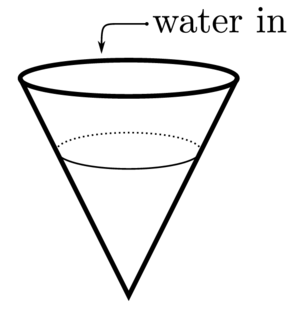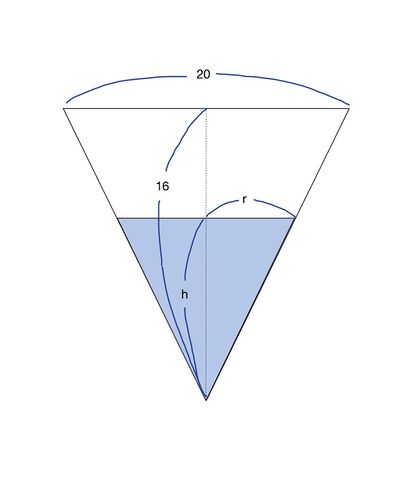Science:Math Exam Resources/Courses/MATH100/December 2015/Question 08 (a)
{{#incat:MER QGQ flag|{{#incat:MER QGH flag|{{#incat:MER QGS flag|}}}}}}
• Q1 (i) • Q1 (ii) • Q1 (iii) • Q1 (iv) • Q2 (i) • Q2 (ii) • Q2 (iii) • Q2 (iv) • Q3 (i) • Q3 (ii) • Q3 (iii) • Q3 (iv) • Q4 (a) • Q4 (b) • Q4 (c) • Q4 (d) • Q5 (a) • Q5 (b) • Q5 (c) • Q5 (d) • Q6 (a) • Q6 (b) • Q6 (c) • Q6 (d) • Q7 • Q8 (a) • Q8 (b) • Q9 • Q10 (a) • Q10 (b) • Q10 (c) • Q10 (d) • Q10 (e) • Q10 (f) • Q10 (g) • Q10 (h) • Q11 (a) • Q11 (b) • Q12 (a) • Q12 (b) • Q12 (c) •
Question 08 (a) |
|---|
A tank of water in the shape of an inverted circular cone of height 16 m and diameter 20 m at the top is being filled with water at a rate of 2 m3 per minute.  (a) Draw a vertical cross-section of the cone and label it with all the lengths that appear in your solution to part (b). |
|
Make sure you understand the problem fully: What is the question asking you to do? Are there specific conditions or constraints that you should take note of? How will you know if your answer is correct from your work only? Can you rephrase the question in your own words in a way that makes sense to you? |
|
If you are stuck, check the hints below. Read the first one and consider it for a while. Does it give you a new idea on how to approach the problem? If so, try it! If after a while you are still stuck, go for the next hint. |
Hint 1 |
|---|
|
What kind of dimensions do we need to solve the Question 08 (b)? |
Hint 2 |
|---|
|
If at time the height of the water is , how would a vertical cross-section look? What extra information does the volume give? |
|
Checking a solution serves two purposes: helping you if, after having used all the hints, you still are stuck on the problem; or if you have solved the problem and would like to check your work.
|
Solution |
|---|
|
Since we want to know the rate of the change of the height of the water, we need a variable for the height. On the other hand, to use the given information on the rate of the change of the volume of the water, we introduce a variable for the radius of the circle at the top of the water. These two variables can be described on the picture of the vertical section as follows: |
{{#incat:MER CT flag||
}}




